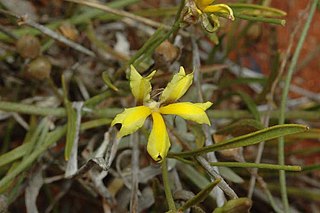Related Research Articles

The crab-eating macaque, also known as the long-tailed macaque and referred to as the cynomolgus monkey in laboratories, is a cercopithecine primate native to Southeast Asia. A species of macaque, the crab-eating macaque has a long history alongside humans; it has been alternately seen as an agricultural pest, sacred animal in some temples, and more recently, the subject of medical experiments.

The Nicobar long-tailed macaque is a subspecies of the crab-eating macaque, endemic to the Nicobar Islands in the Bay of Bengal. This primate is found on three of the Nicobar Islands—Great Nicobar, Little Nicobar and Katchal—in biome regions consisting of tropical and subtropical moist broadleaf forests.

Asclepias fascicularis is a species of milkweed known by the common names narrowleaf milkweed and Mexican whorled milkweed.

Astartea fascicularis is a species of flowering plant in the myrtle family, Myrtaceae. It is endemic to southwestern Western Australia, where it is widespread in the Recherche Archipelago and present on the mainland in Cape Le Grand National Park. It is commonly known as Recherche astartea. or false baeckea.

The Philippine long-tailed macaque is a subspecies of the crab-eating macaque, known in various Philippine languages as matching/matsing or the more general term unggoy ("monkey"). It is endemic to the Philippine forests and woodlands, but especially in the mangrove forests of western central Philippines— particularly in Palawan, the Visayas, and Mindanao. The names M. f. philippinensis and M. f. philippinenesis have also been used, but arise from orthographical error.

Dosima fascicularis, the buoy barnacle, is "the most specialised pleustonic goose barnacle" species. It hangs downwards from the water surface, held up by a float of its own construction, and is carried along by ocean currents.

Fissurella fascicularis, common name the wobbly keyhole limpet, is a species of sea snail, a marine gastropod mollusk in the family Fissurellidae, the keyhole limpets.

Darwinia fascicularis is shrub in the myrtle family and is endemic to areas near Sydney. A small shrub with aromatic foliage and white flowers, turning red as they mature. Nectar feeding birds are attracted to its flowers as a food source.

Capparis fascicularis, the zigzag caper-bush, is a plant in the Capparaceae family and is native to Africa.

Trichostetha fascicularis is a large, metallic-green beetle found in South Africa.

Galaxea is a genus of colonial stony corals in the family Euphylliidae. Common names include crystal, galaxy, starburst and tooth coral. They are abundant on reefs in the Indo-Pacific region and the Red Sea. They are found in water less than 20 metres (66 ft) deep and favour turbid sites. They are sometimes kept in reef aquaria.

Galaxea fascicularis is a species of colonial stony coral in the family Euphylliidae, commonly known as octopus coral, fluorescence grass coral, galaxy coral among various vernacular names.

Trichostetha is a genus of beetle in the scarab beetle family. It is endemic to southern Africa, and its species most commonly occur in mountainous terrain. The genus includes several species that have only recently been described, as well as many species lacking a description of any of the larval stages. Except for T. fascicularis and its subspecies, the species comprising Trichostetha have small ranges of distribution, frequently in the Cape Floral Region of South Africa.

Pterolophia is a genus of longhorn beetles of the subfamily Lamiinae, containing the following species:
Pterolophia instabilis is a species of beetle in the family Cerambycidae. It was described by Per Olof Christopher Aurivillius in 1922. It is known from Seychelles.
Pterolophia guineensis is a species of beetle in the family Cerambycidae. It was described by James Thomson in 1864, originally under the genus Alyattes.

Ranunculus fascicularis, commonly called early buttercup, is a species of flowering plant in the buttercup family (Ranunculaceae). It is native to the eastern North America, where it is found in Canada and the United States. It is generally widespread in eastern North America, although its populations become sporadic in areas east of the Appalachian Mountains and south of New England. Its natural habitat is in dry areas with sparse vegetation, such as rocky or sandy bluffs, prairies, and savannas.
Rumex fascicularis is a plant from the family Polygonaceae. This specific plant species experiences perennial growth and is originally found in North Carolina. Rumex fascicularis is from the genus Rumex, which are herbs and it is commonly seen growing near swamps, shores of rivers and lakes.

Goodenia fascicularis, commonly known as silky goodenia, is a species of flowering plant in the family Goodeniaceae and is widely distributed in eastern continental Australia. It is an ascending perennial herb with linear to egg-shaped leaves and racemes of yellow flowers.
References
- ↑ BioLib.cz - Pterolophia fascicularis. Retrieved on 8 September 2014.